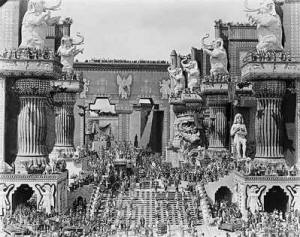Intolerance (1916)

Stung by the criticism of BoaN, in 1916 Griffith made Intolerance, a film about hypocrisy, bigotry, religious hatred,
persecution, discrimination and injustice*.
About the same length as Birth of a Nation, the film is radical because it attempts to weave 4 widely
disparate stories into a single narrative. Modern critics love
it, but it audiences of its era did not.
Next: later Griffith

Here are the four stories that are told in Intolerance and the color of the film stock on which they are shown:
THE 'MODERN' STORY (A.D. 1914):
(Amber Tint) In early 20th
century America during a time of labor unrest, strikes, and
social change in California and ruthless employers and
reformers - a young Irish Catholic boy, an exploited worker,
is wrongly imprisoned for murder and sentenced to be hung on
a gallows. The boy is saved from execution in a last-minute
rescue by his wife's arrival with the governor's pardon.
THE JUDAEAN STORY (A.D. 27):
(Blue Tint) The Nazarene's
(Christ's) Judaea at the time of his struggles with the
Pharisees, his betrayal and crucifixion (told as a Passion
Play in his last days) - it is the shortest of the four
stories.
THE FRENCH STORY (A.D. 1572):
(Sepia Tint) Renaissance,
16th century medieval France at the time of the persecution
and slaughter of the Huguenots during the regime of Catholic
Catherine de Medici and her son King Charles IX of France,
and the notorious atrocities of St. Bartholomew's Day
Massacre (including its effects upon the planned wedding of
a young innocent Huguenot couple - Brown Eyes and Prosper
Latour).
THE BABYLONIAN STORY (539 B.C.): (Gray-Green Tint) peace-loving Prince Belshazzar's Babylon at the time of its
Siege and Fall by King Cyrus the Persian, due to the
treacherous High Priests - and the Mountain Girl's vain
efforts to avert the tragedy. The outdoor set for the
Babylonian sequences was the largest ever created for a
Hollywood film up to its time, and its crowd shots with
16,000 extras were also some of the greatest in cinematic
history.
*It's a little hard to understand just what Griffith was trying to accomplish with Intolerance (other than a really big, imaginative picture). One common read is that Griffith was essentially making an early (and absurd) reverse racism claim: Black people and their supporters were being intolerant of HIS racism! It's certainly true that Griffith never recanted anything of Birth of a Nation. I think the message of Intolerance probably is that everyone should love one another bosses should love employees etc. etc... Of course one key to all this love is the unquestioning acceptance of white supremacy.

